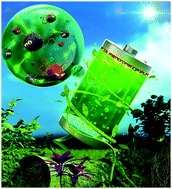当前位置:
X-MOL 学术
›
Energy Environ. Sci.
›
论文详情
Our official English website, www.x-mol.net, welcomes your
feedback! (Note: you will need to create a separate account there.)
A biomass based free radical scavenger binder endowing a compatible cathode interface for 5 V lithium-ion batteries†
Energy & Environmental Science ( IF 32.4 ) Pub Date : 2018-11-17 00:00:00 , DOI: 10.1039/c8ee02555j Yue Ma 1, 2, 3, 4, 5 , Kai Chen 1, 2, 3, 4, 5 , Jun Ma 1, 2, 3, 4, 5 , Gaojie Xu 1, 2, 3, 4, 5 , Shanmu Dong 1, 2, 3, 4, 5 , Bingbing Chen 1, 2, 3, 4, 5 , Jiedong Li 1, 2, 3, 4, 5 , Zheng Chen 1, 2, 3, 4, 5 , Xinhong Zhou 4, 5, 6, 7 , Guanglei Cui 1, 2, 3, 4, 5
Energy & Environmental Science ( IF 32.4 ) Pub Date : 2018-11-17 00:00:00 , DOI: 10.1039/c8ee02555j Yue Ma 1, 2, 3, 4, 5 , Kai Chen 1, 2, 3, 4, 5 , Jun Ma 1, 2, 3, 4, 5 , Gaojie Xu 1, 2, 3, 4, 5 , Shanmu Dong 1, 2, 3, 4, 5 , Bingbing Chen 1, 2, 3, 4, 5 , Jiedong Li 1, 2, 3, 4, 5 , Zheng Chen 1, 2, 3, 4, 5 , Xinhong Zhou 4, 5, 6, 7 , Guanglei Cui 1, 2, 3, 4, 5
Affiliation

|
5 V lithium ion batteries (LIBs) are promising candidates for high energy density batteries. However, conventional carbonate-based liquid electrolyte is vulnerable to oxidative decomposition caused by free radical attack, which leads to poor cycling performance of the 5 V LIBs. Herein, we present a novel strategy based on the free radical scavenging effect to suppress the electrolyte decomposition of 5 V class batteries composed of LiNi0.5Mn1.5O4 (LNMO) cathodes and carbonate-based electrolyte. Our strategy is to scavenge the free radicals during the charging process at the cathode interface by adopting a renewable biomass lignin binder with numerous phenol groups, which can significantly suppress the free radical chain reaction and subsequently generate a compatible multi-dimensional interphase between the electrode and electrolyte. The lignin based electrode exhibited a capacity retention of 94.1% after 1000 cycles, which is significantly higher than that of its PVDF counterpart (46.2%). This work represents a milestone contribution to the strategy for resolving the interfacial issue of high voltage cathode materials, initiating a big step in boosting 5 V batteries.
中文翻译:

基于生物质的自由基清除剂粘合剂,可为5 V锂离子电池提供兼容的阴极界面†
5 V锂离子电池(LIB)是高能量密度电池的有前途的候选者。然而,常规的基于碳酸盐的液体电解质容易受到由自由基攻击引起的氧化分解的影响,这导致5V LIB的较差的循环性能。本文中,我们提出了一种基于自由基清除作用的新型策略,以抑制由LiNi 0.5 Mn 1.5 O 4组成的5 V级电池的电解质分解(LNMO)阴极和碳酸盐基电解质。我们的策略是在充电过程中通过采用具有许多酚基团的可再生生物质木质素粘合剂清除阴极界面上的自由基,该粘合剂可以显着抑制自由基链反应,并随后在电极与电极之间产生兼容的多维界面。电解质。木质素基电极在1000次循环后显示出94.1%的容量保持率,明显高于其PVDF对应物的容量保持率(46.2%)。这项工作对解决高压阴极材料的界面问题的战略做出了里程碑式的贡献,为提高5 V电池的容量迈出了一大步。
更新日期:2018-11-17
中文翻译:

基于生物质的自由基清除剂粘合剂,可为5 V锂离子电池提供兼容的阴极界面†
5 V锂离子电池(LIB)是高能量密度电池的有前途的候选者。然而,常规的基于碳酸盐的液体电解质容易受到由自由基攻击引起的氧化分解的影响,这导致5V LIB的较差的循环性能。本文中,我们提出了一种基于自由基清除作用的新型策略,以抑制由LiNi 0.5 Mn 1.5 O 4组成的5 V级电池的电解质分解(LNMO)阴极和碳酸盐基电解质。我们的策略是在充电过程中通过采用具有许多酚基团的可再生生物质木质素粘合剂清除阴极界面上的自由基,该粘合剂可以显着抑制自由基链反应,并随后在电极与电极之间产生兼容的多维界面。电解质。木质素基电极在1000次循环后显示出94.1%的容量保持率,明显高于其PVDF对应物的容量保持率(46.2%)。这项工作对解决高压阴极材料的界面问题的战略做出了里程碑式的贡献,为提高5 V电池的容量迈出了一大步。











































 京公网安备 11010802027423号
京公网安备 11010802027423号